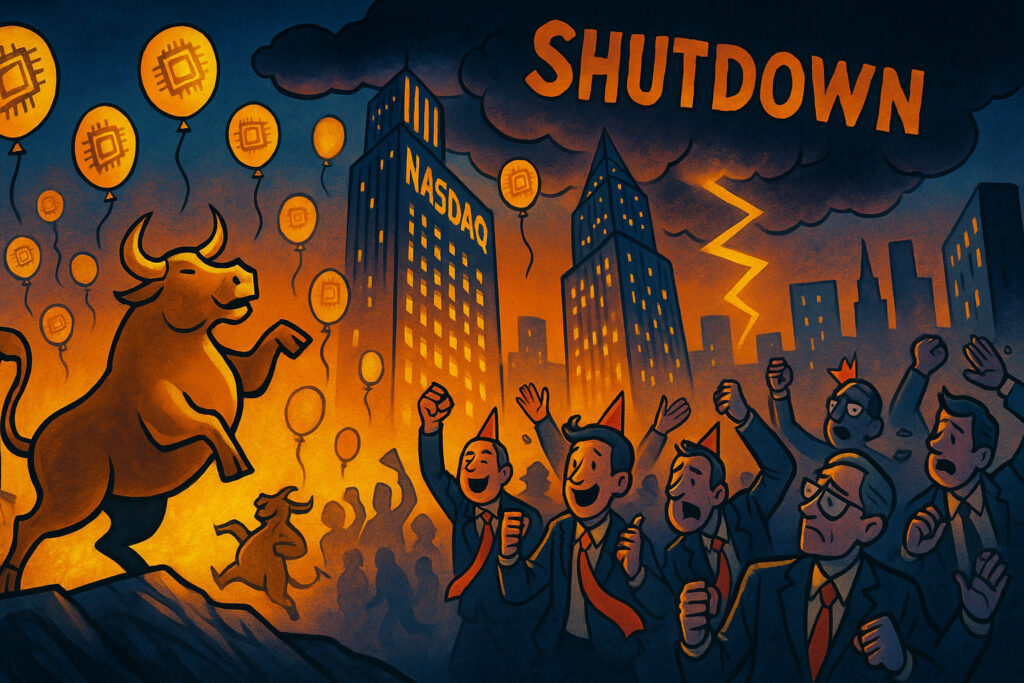Introduction
On 29 September 2025, markets awoke from recent turbulence and pushed higher again. The S&P 500 rose about 0.6%, the Dow Jones Industrial Average jumped roughly 0.7%, and the Nasdaq Composite climbed 0.4%. All 11 broad sectors across the S&P posted gains. Technology and semiconductor names led the way as investors looked past hawkish Fed remarks and refocused on key optimism drivers: a viable rate cut trajectory, positive inflation data, and the resilience of AI and infrastructure themes.
Yet the rebound was not without its shadows. The specter of a looming U.S. government shutdown cast uncertainty over future data flows. Markets were celebrating momentum, but doing so against a backdrop where critical economic releases—such as the jobs report—might be delayed due to funding gaps. After all, when data disappears, policy guidance becomes harder to interpret and act on.
In short: 29 September looked like a market regaining confidence—but also a market conscious of fragility.
Body
Equity Gains: Broad-Based Rally
The trading day was marked by broad rallies across sectors. The S&P 500 added about 38.98 points to close near 6,643.7, with all 11 sectors finishing in the green.
The Dow Jones jumped nearly 300 points (0.7%), closing at 46,247.29, with 24 of its 30 components advancing.
The Nasdaq Composite added about 99.37 points (roughly 0.4%) to close at 22,484.07.
Tech and semiconductors were clearly in leadership mode again. Nvidia, Micron, Lam Research, and related infrastructure names outperformed, fueling the rally. Meanwhile, communication services and discretionary names also performed well. Energy lagged, pulling on the Dow as crude prices softened.
The rally was confirmed by breadth: advancing issues significantly outnumbered decliners, and the CBOE Volatility Index (VIX) slipped, pointing to lower stress levels heading into week’s end.
Inflation, Fed, and Momentum
Investors found renewed confidence in recent inflation data and central bank commentary. Although some Fed officials leaned cautious, markets had already largely priced in a 25-basis-point cut at the next meeting—with probability levels hovering above 90%. The persistence of that discounting despite hawkish signals suggested strong belief in the easing narrative.
A key underpinning of the rally was relief that inflation prints had not worsened dramatically. The PCE inflation gauge, a preferred metric for the Federal Reserve, registered a 0.3% monthly rise, bringing the annual reading to 2.7%. Core PCE, excluding food and energy, came in at 2.9% year-over-year. While still elevated, those numbers helped markets believe that inflation might stabilize rather than rekindle.
Markets seemed to treat hawkish remarks as noise, anchoring on policy expectations and growth leanings. The rebound was a statement: the bulls are not capitulating easily.
Technology & Semiconductors: Reignited
Technology, especially semiconductor and AI infrastructure plays, led the charge. Nvidia, Micron, Lam Research and others capitalized on renewed interest in generative AI, cloud growth, and data center investment.
Storage names like Western Digital and Seagate also saw outsized gains, with analysts raising price targets and reaffirming bullish momentum.
These gains were not isolated: the technology surge pulled broader indices upward, indicating that infrastructure optimism is still central to equity narratives.
Sector Rotation & Defensive Support
While tech led, rotation was evident:
- Consumer discretionary and materials posted strong gains, supporting the impression of a broader rally.
- Utilities, consumer staples, and healthcare delivered steady, less volatile performance, helping calmer hands find footing.
- Financials benefited modestly as the curve steepened marginally during the session.
- Real estate was mixed: some REITs rallied modestly on yield relief, but sensitivity to rate risk kept sentiment cautious.
- Energy underperformed. Oil prices declined, which weighed on integrated and exploration names, dragging parts of the Dow.
The message: investors were not backing away from growth, but blending it with stability and defensive stances.
Bonds, Yields & Market Tension
Bond markets showed mixed signals. Long-term yields had a modest decline from prior highs, reflecting renewed optimism. Short-term yields held firm, reflecting ongoing uncertainty about how much further the Fed will ease.
The yield curve steepened slightly—a positive sign for equity revaluation—but inversion remained a concern and reminded investors of the delicate balance. Credit spreads remained compressed, indicating risk appetite remained intact.
Still, bond markets continued to act as a counterbalance—not full believers in the equity surge, but not obstructing it either.
Shutdown Risk & Data Delays
One of the biggest overhangs was the risk of a government shutdown. With appropriations expiring imminently, the deadline loomed large. If the shutdown takes effect, key economic reports—including the non-farm payrolls and CPI releases—could be delayed or shelved temporarily.
Without those data streams, the Federal Reserve might be forced to rely more heavily on private indicators and lagging metrics—introducing policy ambiguity and volatility. Markets price on information; when information is constrained, uncertainty grows.
Investors were acutely aware that momentum could restart only if clarity returns. Until then, momentum is fragile, and optimism must be paired with caution.
Conclusion
29 September 2025 was a day of regained confidence. The S&P 500, Dow, and Nasdaq all posted gains, with tech and semiconductors leading the charge. Inflation data and the expectation of further rate cuts provided fuel, while rotation across sectors added back structural support.
Yet beneath the gains lies tension: yields remain sensitive, data risks loom large, and the potential for a government shutdown injects fragility. The rally is alive—but not unopposed.
Key Questions Ahead
- Will the Fed push forward with rate cuts or slow down in light of hawkish voices?
- Can the technology-led gains sustain if yields drift upward or liquidity tightens?
- How far will sector rotation go—can cyclicals and value carry the load?
- What happens if critical data releases are delayed or suspended?
- Will geopolitical, fiscal, or macro surprises unsettle the recent momentum?
29 September may be remembered as the day momentum resumed. But the real test lies ahead.
